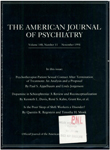Postcardiotomy delirium: conclusions after 25 years?
Abstract
Although postcardiotomy delirium has been studied widely, there are few data about the current prevalence, compared to that reported in the late 1960s. There have been few efforts to replicate early observations. The authors review the literature using meta-analysis to combine the results of 44 studies. They examined the relationships between postcardiotomy delirium and 28 hypothesized risk variables. The prevalence of postcardiotomy delirium has remained fairly constant over time at 32%. There was no difference in the total prevalence of postcardiotomy delirium reported in studies that used interviews versus chart reviews. Sex, previous psychiatric illness, intelligence, and time on bypass failed to correlate with postcardiotomy delirium, and age correlated with it only slightly. Correlation coefficients of more than 0.30 were found only for noncongenital heart disease and postoperative EEG abnormality. Preoperative psychiatric intervention had the highest correlation with postcardiotomy delirium (r = -0.60).
Access content
To read the fulltext, please use one of the options below to sign in or purchase access.- Personal login
- Institutional Login
- Sign in via OpenAthens
- Register for access
-
Please login/register if you wish to pair your device and check access availability.
Not a subscriber?
PsychiatryOnline subscription options offer access to the DSM-5 library, books, journals, CME, and patient resources. This all-in-one virtual library provides psychiatrists and mental health professionals with key resources for diagnosis, treatment, research, and professional development.
Need more help? PsychiatryOnline Customer Service may be reached by emailing [email protected] or by calling 800-368-5777 (in the U.S.) or 703-907-7322 (outside the U.S.).



